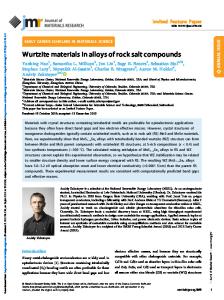Radiation Induced Sodium Metal Colloid Formation in Natural Rock Salt From Different Geological Localities
- PDF / 946,569 Bytes
- 8 Pages / 417.6 x 639 pts Page_size
- 66 Downloads / 339 Views
Topp,
Inc.
433
editor
RADIATION INDUCED SODIUM METAL COLLOID FORMATION IN NATURAL ROCK SALT FROM DIFFERENT GEOLOGICAL LOCALITIES*
J. M. LOMAN,** P. W. LEVY,t AND K. J. SWYLERtt Brookhaven National Laboratory, Upton, New York
11973,
U.S.A.
ABSTRACT Radiation damage has been studied in natural rock salt from various localities, including potential repository sites. In the 100 to 300 C range the damage consists of point defects, primarily F-centers, and colloidal metal sodium particles. With increasing dose the F-centers grow to a saturation level, reached at 107 -108 rad, that decreases with increasing temperature to a negligible level at 300 C. Colloid concentration vs. irradiation-time curves follow nucleation and growth curves accurately described by C tn, or C(dose)n, relations at large irradiation times. For fourteen samples, n= 1.85± 0.18 but the values of C vary by a factor of more than 103. The constant C is related to the sample strain, the impurity and void content, dose rate, and possibly other factors. The currently available data indicate that rock salt adjacent to radioactive waste canisters, at a temperature of 150 C, will contain between 0.01 and 10 mole percent of sodium metal when the total dose reaches 1010 rad.
INTRODUCTION Gamma-ray induced radiation damage, particularly Na metal colloid formation, has been studied in natural rock salt from different geological localities, including some potential radioactive waste repository sites, and different horizons at certain locations. The basic radiation damage phenomenology in both synthetic melt grown NaCl crystals and natural evaporite rock salt has been described in numerous Office of Nuclear Waste Isolation (ONWI) reports, in previous publications [l]-13] and in a summary article [4]. This article will emphasize measurements on radiation related parameters that are important for radioactive waste repository site selection, design, safety assessment, etc. in both bedded and dome salt. Also included are comments on unresolved radiation related problems, especially the possibility that chlorine gas will be generated from irradiated rock salt.
*Research supported by the Dept. of Energy Office of Nuclear Waste Isolation, operated by Battelle Inst.-Columbus, Ohio, and the Dept. of Energy Division of Basic Energy Sciences, under contract DE-AC02-76CH00016.
"**Now with
Ford Aerospace and Communications Corp.,
Palo,
Alto, California.
tPhysics Department ttNow with Brookhaven National Laboratory Dept. of Nuclear Energy - NRC Nuclear Waste Management Division.
434 EXPERIMENTAL DETAILS All measurements described below were made with equipment at Brookhaven National Laboratory for making optical absorption and luminescence measurements on samples while they are being irradiated with monoenergetic electrons, of selected energy, between 0.5 and 3.0 MeV. Samples ý.reirradiated in a temperature controlled chamber containing an exchange gas. Except for dose rate studies, the dose rate was 1.2x 108 rad/hr; appreciably above that expected in repositori
Data Loading...











